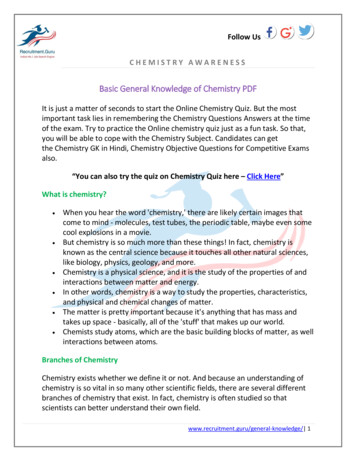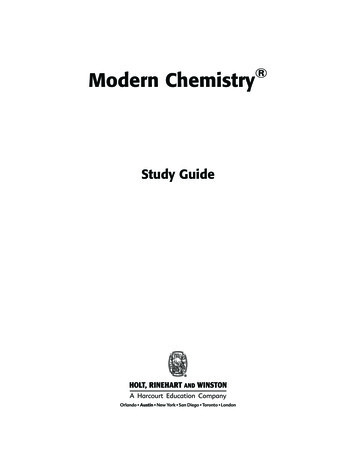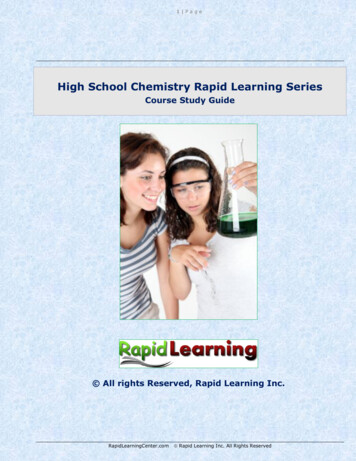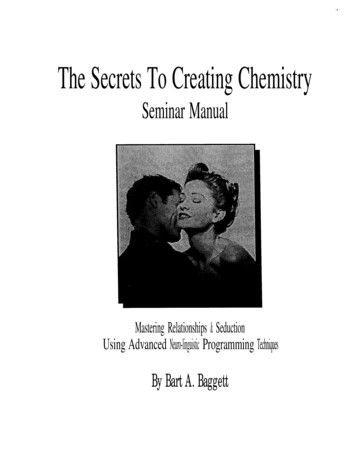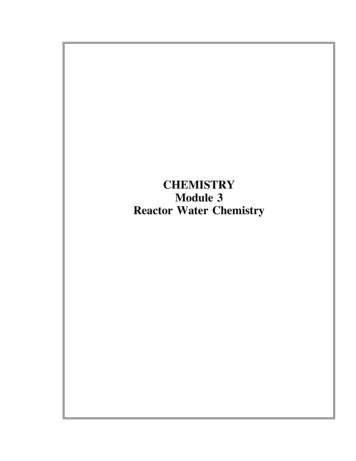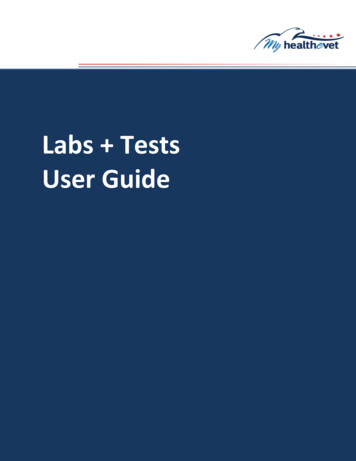
Transcription
IndustrialChemistryPrepared by Helen Njeri NJENGAAfrican Virtual universityUniversité Virtuelle AfricaineUniversidade Virtual Africana
African Virtual University NoticeThis document is published under the conditions of the Creative Commonshttp://en.wikipedia.org/wiki/Creative ses/by/2.5/License (abbreviated “cc-by”), Version 2.5.
African Virtual University Table of ContentsI.Industrial Chemistry 3II.Prerequisite Course or Knowledge 3III.Time 3IV.Materials 4V.Module Rationale 4VI.Content 56.16.26.3Overview 5Outline 5Graphic Organizer 7VII. General Objective(s) 8VIII. Specific Learning Activities 8IX.Pre-assessment 11X.Compiled List of all Key Concepts (Glossary) 14XI.Compiled List of Compulsory Readings 15XII. Compiled List of Resources 16XIII. Compiled List of Useful Links 17XIV. Learning Activities 20XV. Synthesis of the Module 162XVI. Summative Evaluation 163XVII. References 165XVIII. Student records 166XIX. Main Author of the Module 166XX. File Structure 167
African Virtual University I. Industrial ChemistryBy Dr. Helen Njeri Njenga, University of Nairobi and William WanasoloII. Prerequisite Courses or KnowledgeModule 5Unit IUnit IIUnit IIIUnit IVBasic Organic ChemistryHydrocarbonsAlkyl halidesAminesModule 6Unit I Alcohols and ethersUnit III Carboxylic acids and their derivativesModule 7Unit I Benzene and its derivativesUnit III Heterocyclic compoundsModule 9ThermodynamicsChemical principles of variable constituentsIII. TimeThis unit will require 120 hours Unit I Introduction to industrial chemistry and the chemical industry (15 hrs)Unit 2. Unit Operations and Unit Processes (20 hrs)Unit 3. Industrial Inorganic Chemistry I (Extractive Metallurgy) (10 hrs)Unit 4. Industrial Inorganic Chemistry II (Chlor-alkali, Ammonia, SulphuricAcid, Fertilizer and Cement) (20 hrs)Unit 5. Industrial Organic Chemistry I (Petroleum, Petrochemicals and Polymers) (25 hrs)Unit 6. Industrial Organic Chemistry II (Fermentation, Ethanol, Pharmaceuticals, Soaps and Detergents) (25 hrs)
African Virtual University IV. MaterialsYou will require the following tools and resources for completing the module:Computer, CD-ROM, and e-library To access this module, exams and other relevant material To access other suggested reference materials For interactive discussions/chat sessionsRecommended textbooks and reference materials To assist learning and further understanding of topics in the moduleV. Module RationaleIndustrial chemistry deals with commercial production of chemicals and relatedproducts from natural raw materials and their derivatives. It enables humanity toexperience the benefits of chemistry when we apply it in the exploitation of materialsand energy. When we apply chemistry in the transformation of materials and energyto make useable products, this results in growth and improvement in areas such asfood production, health and hygiene, shelter and clothing. The economic growth ofindustrialized countries relies on the manufacturing industry for finished products. Thegoal of studying industrial chemistry at university is to try and bridge the gap betweenclassical chemistry and chemistry is applied in industry. The chemical industry ishighly globalized and produces thousands of chemicals from a wide variety of rawmaterials by means of varied technologies for varied end uses. It is therefore importantto base the study of industrial chemistry on an understanding of the structure of theindustry and the unit operations and unit processes that make up the chemical processes. On the basis of natural raw materials sources and the chemistry involved, wefind it easier to study industrial inorganic and industrial organic chemistry separately,Through the electrolysis of brine, we obtain chlorine and sodium hydroxide both ofwhich are important reactants in organic synthesis of products such as petrochemicalsand detergents respectively. By fixing nitrogen, we obtain ammonia, from whichwe can make fertilizers. From sulphur, we get sulphuric acid, which we use, in themanufacture of phosphate fertilizers. Mineral ores as well as being raw materials forbasic chemicals are the source of pure metals, which we use elsewhere in buildingand construction, manufacture of equipment, machines and jewellery. Turning nowto organic chemical industry, we use petroleum as the source of petrochemicals andsynthetic polymers. Fermentation enables us to convert natural organic materials intochemicals, some like penicillin being pharmaceutical ingredients. From natural oilsand fats, we obtain soaps and detergents.
African Virtual University VI. Content6.1 OverviewThis module starts by defining industrial chemistry and then gives a view of thechemical industry, its position in the general economy, and its classification in termsof the chemical processes that characterize it. To enable the study of selected chemical processes, unit operations and unit processes, especially those that are relevantin later learning actvities, are then covered in Unit 2. With this background, it willbe easy to study industrial inorganic and organic chemical industries. The study ofextractive metallurgy in Unit 3 draws on the knowledge of size reduction and separation unit operations learnt earlier, as well as chemical conversions that take placeduring pyroprocessing. The extractive metallugy of iron, copper and aluminium isincluded. In Unit 4, we focus our attention on some basic inorganic industrial processes that synthesize products from a variety of raw materials derived from the naturalenvironment. They include manufacture of chlorine and sodium hydroxide frombrine, ammonia from methane and nitrogen, sulphuric acid from sulphur, fertilizerand cement from mineral ores. The study of organic industrial chemistry then startswith petroleum refining followed by the manufacture of selected petrochemicalsand polymers. The module closes with the study of ethanol, pharmaceuticals, soapsand detergents. These are high value-added products, some of which are producedthrough the fermentation route.6.2 OutlineUnit 1: Introduction to Industrial Chemistry (15 hours) Introduction to industrial chemistryClassification of the chemical industryRaw materials for the chemical industryUnit operations and unit processes that make up chemical processesFlow diagramsMaterial and energy balancesUnit 2: Unit operations and unit processes (20 Hours) Size reduction and size enlargementMagnetic and electrostatic separationFroth flotationFractional distillationUnit processes
African Virtual University Unit 3: Inorganic Industrial Chemical Industries Part I: Extractivemetallurgy (10 Hours) Mineral oresOre dressingPyroprocessingRefiningExtractive metallurgy of ironExtractive metallurgy of aluminiumExtractive metallurgy of copperUnit 4 : Inorganic Chemical industries Part II: Chlor-alkali, Ammonia,Sulphuric Acid, Fertilizer, Cement (25 hours) Sodium hydroxide and ChlorineAmmoniaSulphuric acidFertilizerCementUnit 5: Organic Chemical IndustriesI : Petroleum, Petrochemicals andPolymers (25 hours) Petroleum processingPetrochemicalsPolymersUnit 6: Organic Chemical Industries II Fermentation, Ethanol,Pharmaceuticals, Soaps and Detergents (25 hours) FermentationEthanolPharmaceuticalsSoaps and detergents
African Virtual University 6.3 Graphic mistryGeneralIndustrialChemistryIntroduction toindustrialchemistry andchemicalindustryUnit operationsand nia,sulphuric etroleum,petrochemicalsand polymersFermentation,ethanol,pharmaceuticals,soaps anddetergents
African Virtual University VII. General Objective(s)At the end of this module you should be able to:i.ii.iii.iv.v.vi.Classify the chemical industry in terms of products, raw materials, scale andtypes of transformations.Describe the operation principles of selected unit operations and unit processes.Describe metal extraction in general and the extractive metallurgy of iron,aluminium and copper in particular.Discuss with the help of relevant flow diagrams, equations, operating conditions and equipment principles, the manufacture of chlorine, sodium hydroxide,ammonia, sulphuric acid, fertilizer and cement.Explain using flow diagrams and equations, how crude oil is refined, and howsome petrochemicals and polymers are synthesized.Discuss fermentation theory and its application in ethanol manufacture, theproduction of some pharmaceuticals, soaps and detergents.VIII. Specific Learning Objectives(Instructional Objectives)Unit 1: Introduction to Industrial Chemistry and the Chemical IndustryAt the end of this unit, you should be able to:a. Distinguish between classical and industrial chemistryb. Classify the chemical industry in terms of scale, raw materials, end use andvalue additionc. Distinguish between unit operations and unit processesd. Describe chemical processes by means of flow diagramse. Carry out material balances for a simple processUnit 2: Unit Operations and Unit ProcessesAt the end of this unit you should be able to:a. List the various reasons for undertaking size reduction and enlargement in thechemical industryb. Describe the operation principles of some size reduction equipment and sizeenlargement equipment
African Virtual University c. Explain how industrial materials can be separated on the basis of their magnetic, electrostatic, hydrophobic and volatility differences respectivelyd. Discuss various organic unit processes including polymerization, alkylation,hydrolysis and their application in the chemical industry.Unit 3: Inorganic Chemical Industries Part I: Extractive MetallurgyAt the end of this unit you should be able to:a. Describe the various stages mineral ores go through in a typical mineral oredressing process.b. Write equations to describe calcination and roastingc. Explain what happens during smeltingd. Describe the extractive metallurgy of irone. Describe the extractive metallurgy of aluminiumf. Describe the extractive metallurgy of copperUnit 4: Inorganic chemical Industries Part II: Chlor-alkali, Ammonia,Sulphuric Acid, Fertilizer, CementAt the end of this unit you should be able toa. Describe using equations and diagrams, the electrolytic process for theproduction of sodium hydroxide and chlorine using mercury, diaphram andmembrane cellsb. Explain how ammonia is manufactured from methane and air by the Haberprocessc. Describe the Contact process for the manufacture of sulphuric acidd. Discuss the various types of fertlizers and the manufacture of phosphatefertilizere. Describe using diagrams, equations and unit operations, for the manufactureof Portland cement.Unit 5: Organic Chemical Industries Part I: Petroleum, Petrochemicals andPolymersAt the end of this unit you should be able to:a. Discuss the occurrence and extraction of petroleumb. Explain the purposes and application of fractional distillation, catalytic cracking and catalytic reforming during petroleum processingc. Describe using equations and flow diagrams, the manufacture of some petrochemicals, namely, phthalic anhydride and adipic acid
African Virtual University 10d. Categorize plymerization reactions, polymers and polymer productse. Describe the uses of various plasticsf. Explain how polyethylene and styrene butadiene rubber are manufacturedUnit 6: Organic Chemical Industries Part II: Fermentation, Ethanol,Pharmaceuticals , Soaps and DetergentsAt the end of this unit you should be able to:a. Discuss factors that affect the viability of the fermentation route and thosethat affect fermentation yieldb. Describe the process of manufacuring fermentation ethanolc. Give a brief history of the pharmaceutical industry and the role played byantibioticsd. Describe production process of two pharmaceuticals: penicilin and aspirine. Outline the soap manufacturing processf. Discuss the various types of surfactantsg. Explain how detergents are manufactured
African Virtual University 11IX. Pre-assessmentTitle of Preassessment: Industrail Chemistry Pre-assessment Test9.1 RationaleThe purpose of this test is to assess your current chemistry knowledge that is a prerequisite for successful learning of this module. To do this test, you will require:1. A calculator2. A list of the elements with symbols, atomic numbers and atomic masses3. Conversion tables for scientific unitsQuestions1. Covert the following:a)b)c)d)140 oF to oC2 atm to kPa50 kcal to kJ0.3 kmoles sodium carbonate to Kg sodium carbonate2. Calculate the % nitrogen in each of the following nitrogen fertilizers.a) Ammonium nitrateb) Ammoniac) Diammonium phosphate3.Which are the oxidizing agents in the redox reactions given below?a) 4Fe 3O2b) Cl2 2NaBrc) H2 Cl22Fe2O32NaCl Br22HCl4.0.103g sample of NH4NO3 required 12.8ml of 0.101M NaOH for neutralization.What is the percent purity of the sample?5.Write equations to show how quicklime (CaO) and slaked lime (Ca(OH)2 aremade starting with limestone.
African Virtual University 126. Al2O3 is an amphoteric oxide. Explain what this means.7. (a) Calculate the heat evolved in kJ per g ZnS from the following equation:2ZnS(s) 3O2(g)2ZnO(s) 2SO2(g) Horxn -879kJ(b) Calculate the molarity of 35.4% mass/volume aqueous solution of phosphoricacid (H3PO4).8.Explain how the presence of a catalyst aids the progress of the following reaction:A BC D9. (a) Write the equilibrium constant expression for the following reaction:PCl5(g)PCl3(g) Cl2 (g)(b) What is the equilibrium constant for the reaction in (a) if equilibrium concentrations in a 12 litre vessel are 0.21 moles PCl5, 0.32 moles PCl3, and 0.32moles Cl2?10. (a) Calculate the molar mass of the polyethylene molecule –(CH2-CH2)n - wheren 10,000.(b) How many litres of air (assuming 78% N2, 22% O2 by volume) are needed forthe complete combustion of 1.0 litre of octane C8H18 whose density is 0.70g/ml.Assume density of air is 1.29g/l.
African Virtual University 139.2. Answer b.TOTALAnswerMarks60oC202.65kPa209 aOCaO H2OCa(OH)2It has both acidic and basicproperties111131114.51kJ24.21M2The catalyst lowers the 2activation energy, which is theminimum energy required toinitiate a chemical reaction[PCl3][Cl2]/[PCl5]K 0.0412280,0004.11litres1330
African Virtual University 14X. Key ConceptsAlkylation is the introduction of an alkyl radical by substitution or addition into anorganic compound.Antibiotics are chemical substances that can inhibit the growth of, and even destroy,harmful microorganisms.Catalytic cracking is the breaking up of complex hydrocarbons into simpler molecules in order to increase the quality and quantity of lighter, more desirableproducts and decrease the amount of residuals.Catalytic reforming is a process used to convert low-octane naphthas into highoctane compounds such as toluene, benzene, xylene, and other aromatics whichare useful in gasoline blending and petrochemical processing.Emulsion polymerization is a free radical polymerization that take place in anemulsion consisting of water, monomer, surfactant and other additives.Fermentation is a reaction wherein a raw material is converted into a product by theaction of micro-organisms or by means of enzymes.Fertilizers are chemical compounds given to plants to promote growthIndustrial chemistry as the branch of chemistry which applies physical and chemical procedures towards the transformation of natural raw materials and theirderivatives to products that are of benefit to humanity.Material balance is the application of the law of conservation of mass in theform of equations to satisfy balances of total masses, components and atomicspecies through a process.Ore dressing is the pre-treatment of mineral ores by mainly physical processes toeffect the concentration of valuable minerals and to render the enriched materialinto the most suitable physical condition for subsequent operations.Plastic is a material that contains as an essential ingredient, an organic substance ofa large molecular weight, is solid in its finished state, and, at some stage in itsmanufacture or in its processing into finished articles, can be shaped by flow.Surfactant is a compound consisting of a long, linear, non-polar (hydrophobic) ’tail’with a polar (hydrophilic) ‘head’ which lowers the surface tension of water andallows oil to form an emulsion with waterUnit operations are the physical treatment steps employed in chemical processes totransform raw materials and products into required forms.Unit processes are the chemical transformations or conversions that are performedin a process.
African Virtual University 15XI. Compulsory ReadingsReading # 1Complete reference: Chemical industry: From Wikipedia, the free encyclopediahttp://en.wikipedia.org/Chemical industryAbstract: The chemical industry comprises the companies that produce industrialchemicals. It is central to modern world economy, converting raw materials (oil, natural gas, air, water, metals, minerals) into very many different products. In this sitechemical products are categorized and can be searched by Product name, ProductCategory, Technology etc. Related links and references are also given.Rationale: Unit I of this module deals with general classification and compositionof the chemical industry. Visits to this site will enable you to see how wide is thefield of chemical manufacturing.Reading # 2Complete reference: Emulsion polymerization: From Wikipedia, the free encyclopediahttp://en.wikipedia.org/ Emulsion polymerizationAbstract: This site gives the history, theory, manufacturing process and various ingredients (monomers, co-monomers, initiators, surfactants, non-surfactant stabilizers,other ingredients) and applications of emulsion polymerization. Information on variouspolymers produced by emulsion polymerization can be accessed from this site.Rationale: Emulsion polymerization theory is studied in Unit 2 and applied in Unit5 of the manufacture of two polymers. This site will expose you to much more information on polymerization.Reading # 3Complete reference: Extractive metallurgy: From Wikipedia, the free encyclopediahttp://en.wikipedia.org/Extractive metallurgyAbstract: This site gives definitions and brief discussions on the basic technologiesused in metal extraction. These include mineral processing pyrometallurgy and hydrometallurgy. Extractive metallurgy of various metals can be accessed from this site.Rationale: The site and its links give a good overview of extractive metallurgy. Itsupplements information given in Unit 3 on extractive metallurgy of copper, aluminium and iron.
African Virtual University 16Reading # 4Complete reference: Fertilizer: From Wikipedia, the free ription: Here you will find the history of the fertilizer industry, information onmacronutrients and micronutrients, nitrogen fertilizers and organic fertilizers. Linksto related topics are given.Rationale: This reading will supplement what is provided in this module under thesubject of fertilizer.XII. Compulsory ResourcesComplete reference: CD accompanying this module.PDF files:aluminium.pdfchlor-alkali and aluminium electrolysis.pdfhaber ammonia synthesis.pdfammonia next step.pdfcement.pdfnitric acid and adipic acid.pdf10J ibiotics production.pdfsoaps and detergents.pdfAbstract: The above files provide reading materials, which help you as supplementaryresource materials for this module.Rationale: These resource materials give detailed explanations on theory, manufacturing processes and other information on some of the products covered in this module.These products include aluminium, ammonia, cement, adipic acid, polyethylene,styrene butadiene rubber, antibiotics, soaps and detergents.
African Virtual University 17XIII.Useful LinksUseful Link # 1Title: Process Flow DiagramsURL: http://commons.wikimedia.org/wiki/Category:Process flow diagramsDescription: This website exclusively deals with process flow diagrams, other technical diagrams and photographs of industrial equipment and plants.Rationale: The site can increase your understanding and appreciation of how processdescriptions are presented in the form of diagrams.Useful Link 2Title: How Products are madeURL: www.madehow.comDescription: This site gives explanations and details of manufacturing processesfor a wide variety of products including some chemicals. The site provides step bystep descriptions of the manufacturing process complemented with illustrations anddiagrams. Each product also has related information such as background and history,how the item works, raw materials that are used, product applications, by-productsgenerated, possible future developments, quality control procedures, etc. There areseven volumes in which information is arranged.Rationale: You will find useful information on aspirin in Volume1, acrylic plastics,polyester, gasoline and soap in Volume 2, antibiotics in Volume 4 and aluminium inVolume 5. This information is relevant to various sections of this module.Useful Link # 3Title: Mine EngineerURL: http://www.mine-engineer.com/Description: Mine Engineer.Com has information on mining, minerals, coal, mineralprocessing, coal preparation, equipment used in the mining and process industries.Other related topics are included.Rationale: In this website information to supplement what is presented inthe module will be found on topics such as copper, aluminium, cement, phosphate ore processing, unit operations involving size reduction and separation.
African Virtual University 18Useful Link # 4Title: ElectrochemistryURL: http://electrochem.cwru.ed/encyclDescription: This site gives useful information on industrial application of electrochemistry.Rationale: One article from this website covers the history, Bayer, Hall-Heroult andalternative processes for aluminium production.Useful Link # 5Title: CheresourcesURL: http://www.cheresources.comDescription: Cheresources.com has been providing content and tools to chemicalengineers all over the world. The site has many free chemical engineering resourcesas well as premium content and software for visitors to choose from. Some of thefree articles are targeted for students.Rationale: This is a useful link to search for detailed information on chemical processtechnology for such products as ammonia, sulphuric acid and others covered in thismodule. Some of the articles are from refereed journals.Useful Link # 6Title: The Contact ProcessURL: http://uk.encarta.msn.com/media 761566936/Sulphuric Acid.htmlDescription: This page describes the Contact Process for the manufacture of sulphuric acidRationale: The article explain the reasons for the conditions used in the process. Itlooks at the effect of proportions, temperature, pressure and catalyst on the composition of the equilibrium mixture, the rate of the reaction and the economics of theprocess.Useful link # 7Title: Chemical IntelligenceURL: ription: Chemical Intelligence is a directory of chemicals providing informationon the chemicals covered by ICIS. Chemicals A-Z page leads to information youmay require on any chemical.Rationale: The bulk industrial chemicals category includes those chemicals andmaterials produced in the chemical industry in large quantities. The site also capturesthe main petrochemical intermediates which are produced from the primary olefinsand aromatics building blocks which are further processed into monomers, detergents,adhesives, solvents, plasticizers, lubricants and polymers.
African Virtual University 19Useful link # 8Title: Set laboratoriesURL: http://www.setlaboratoies.comDescription: This site has a wealth of information on petroleum refining.Rationale: Topics covered in this site include the history of petroleum refining, crudeoil extraction and composition, refining processes with flow diagrams and detaileddescriptions. You will find this site useful as you study Unit 5.Useful link # 9Title: Access ExcellenceURL: http:/www.accessexcellence.orgDescription: This site is a resource centre mainly for life sciences including biotechnology. One of the sites, Biotech Applied looks at the practical applications ofbiotechnology and strategies for introducing biotechnology into the classroom. It alsogives one opportunity to interact and collaborate with scientists, teachers and othersto explore the cutting edge of science.Rationale: One particular site:(http://www.accessexcellence.org/LC/SS/ferm biography.html), deals with fermentation.Useful Link # 10Title: Soap and Detergent AssociationURL: chem2.comDescription: This site is for Soap and Detergent Association who represent manufacturers of household, industrial and institutional cleaning products; producers andsuppliers of associated raw materials and finished packaging.Rationale: One of the article in this website is on the manufacturing processes forsoaps and detergents. It includes the history of soap, soap making, chemistry, ingredients and manufacturing processes. The explanations which are in layman’s languageare supplemented with interesting graphic illustrations. This will greatly aid you inthe study of this topic in Unit 6.
African Virtual University 20XIV. Learning ActivitiesActivity 1Introduction To Industrial Chemistry And The Chemical IndustryAt the end of this learning activity, you should be able to:a. Distinguish between classical and industrial chemistryb. Classify the chemical industry in terms of scale, raw materials, end use andvalue additionc. Distinguish between unit operations and unit processesd. Describe chemical processes by means of flow diagramse. Carry out material balances for a simple processSummary of the learning activityThis learning activity introduces you to industrial chemistry and the chemical industry and enables you to study subsequent units more easily. It includes the followingtopics: Introduction to industrial chemistry, classification of the chemical industry,raw materials for the chemical industry, unit operations and unit processes, flowdiagrams, material and energy balances. The various readings given supplement thematerial presented in this module. At the end of the unit, there are exercises you arerequired to do to test your understanding of the unit.List of relevant readings1. Chang R. (1991). Chemistry, 4th Edition, McGraw-Hill Inc. New York.2. Chang R. and Tikkanen W. (1988). The Top Fifty Industrial Chemicals.3. Price R.F. and Regester M.M. (2000), WEFA Industrial Monitor, 2000-2001,John Wiley & Sons Inc., New York.List of relevant resources Computer with internet facility to access links and relevant copywrite freeresourcesCD-Rom accompanying this module for compulsory reading and demonstrationsMultimedia resources like video,VCD,and CD players
African Virtual University 21List of relevant useful ocess flow diagramshttp://www.icis.com/intelligence.aspxThe first website exclusively deals with process flow diagrams, other technicaldiagrams and photographs of industrial equipment and plants. The site can increaseyour understanding and appreciation on how process descriptions are presented inthe form of diagrams.The second website enables you to see how chemicals are categorized for trade andtechnical purposes.1.1. The difference between classical and industrial chemistryBefore we define industrial chemistry, it may be helpful to know that the development of industrial chemistry started when a need to know how various chemicals areproduced in much more than the laboratory scale, arose. Chemistry knowledge wasapplied to furnish the rapidly expanding chemical industries with ‘’recipes’’ whichwe now call chemical processes. Industrial chemistry keeps up with the progress inscience and technology. It incorporates other emerging disciplines such as biotechnology, microelectronics, pharmacology and material science. The discipline is alsoconcerned with economics and the need to protect the environment.We define industrial chemistry as the branch of chemistry which applies physicaland chemical procedures towards the transformation of natural raw materials andtheir derivatives to products that are of benefit to humanity.Classical chemistry (organic, inorganic and physical chemistry) is very essential foradvancing the science of chemistry by discovering and reporting new products, routes and techniques. On the other hand industrial chemistry helps us to close the gapbetween classical chemistry as it is taught in colleges and universities, and chemistry asit is practiced commercially. The scope of industrial chemistry therefore includes: The exploitation of materials and energy in appropriate scaleApplication of science
Chemistry General Industrial Chemistry Industrial Inorganic Chemistry Industrial Organic chemistry Introduction to industrial chemistry and chemical industry Unit operations and unit processes Extractive metallurgy Chlor-alkali, ammonia, sulphuric acid, fertilizer, cement Petrole




